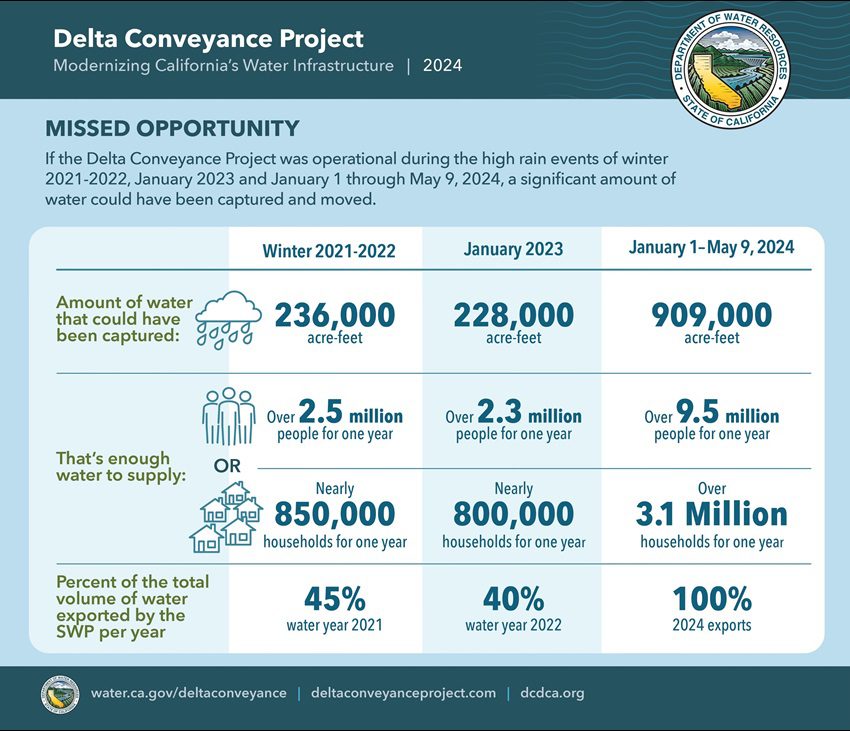- New analysis shows significant benefits exceeding costs.
- Climate change and regulations threaten existing infrastructure.
- Project could save 909,000 acre-feet of water annually.
- Design innovations offer the potential for significant cost savings.
May 23, 2024 — The California Department of Water Resources (DWR) recently unveiled a benefit-cost analysis for the Delta Conveyance Project , a massive infrastructure undertaking to modernize the state’s water delivery system. The findings paint a promising picture, with potential benefits far outweighing the costs.
, a massive infrastructure undertaking to modernize the state’s water delivery system. The findings paint a promising picture, with potential benefits far outweighing the costs.
Benefits Touted in Analysis.
According to the analysis, the project is projected to generate $2.20 in benefits for every dollar invested. These benefits encompass a wide range of improvements, including enhanced water supply reliability, greater resilience to climate change and earthquakes, and improved water quality. Dr. David Sunding, Emeritus Professor at UC Berkeley, who spearheaded the analysis, affirms that “the benefits clearly justify the costs.”
The Looming Threat.
The urgency of the project is underscored by the growing challenges facing California’s existing water infrastructure. The combined effects of climate change and stricter regulations are straining the system, jeopardizing the water supply for 27 million Californians and 750,000 acres of farmland. The Delta Conveyance Project offers a solution to this looming crisis.
Water Savings in a Wet Year.
The project’s potential was highlighted this past year, a particularly wet winter for California. Despite the abundance of water, fishery-related regulations significantly limited water exports from the southern Delta. Had the Delta Conveyance Project been in place, an additional 909,000 acre-feet of water could have been captured from the northern Delta, where fish populations are less vulnerable.


Cost-Efficiency and Design Innovations.
While the estimated cost of the project stands at $20.1 billion , there is a silver lining. The Delta Conveyance Design and Construction Authority (DCA) has identified several design and construction innovations that could potentially slash costs by $1.2 billion. These innovations, ranging from optimizing pumping plant configurations to utilizing advanced tunnel boring technology, demonstrate a commitment to fiscal responsibility.
, there is a silver lining. The Delta Conveyance Design and Construction Authority (DCA) has identified several design and construction innovations that could potentially slash costs by $1.2 billion. These innovations, ranging from optimizing pumping plant configurations to utilizing advanced tunnel boring technology, demonstrate a commitment to fiscal responsibility.
Community Benefits Program.
In addition to the broader benefits, the project has set aside $200 million for a Community Benefits Program. This initiative aims to mitigate the local impacts of construction and provide tangible benefits to the communities directly affected. The program will fund local projects, support job training and business development, and potentially leave behind lasting infrastructure improvements like broadband.
The Cost of Doing Nothing.
In a state grappling with the ever-present threat of drought and the growing impacts of climate change, the Delta Conveyance Project represents a significant step towards a more secure and sustainable water future. With its benefit-cost ratio, innovative design solutions, and commitment to community well-being, proponents of the project believe the investment in California’s water infrastructure offers a viable and promising alternative to the status quo and could safeguard California’s water resources for generations to come.
Karla Nemeth, Director of DWR , says, “There is a very real cost to do nothing,”
, says, “There is a very real cost to do nothing,”
RESOURCES:
- Benefit Cost Analysis

- Cost Estimate

- Facts About the Economic Value of the Delta Conveyance Project

- FAQ: Understanding Costs, Benefits, Funding and Financing for the Delta Conveyance Project

Top Image:
“A drone view of the Bethany Reservoir, impounded by five dams in Alameda County, serves as a forebay for the South Bay Pumping Plant and afterbay for Banks Pumping Plant,” via California Department of Water Resources’ news release.


Leave a Reply